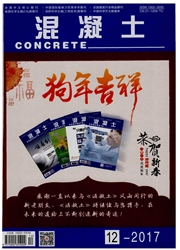

 中文摘要:
中文摘要:
体积膨胀是水泥基材料硫酸盐侵蚀的主要劣化模式之一,一般认为体积膨胀的机理是由于外部硫酸根离子与水泥基材料内部水化铝酸钙、单硫型硫铝酸三钙、来水化的铝酸三钙和氢氧化钙等易受侵蚀化合物反应,形成膨胀性的石膏或钙矾石——侵蚀生成物所致。本文采用室温下5%硫酸钠溶液浸泡试验,研究浸泡后砂浆试件的线长度变化,探讨掺粉煤灰水泥砂浆受硫酸盐侵蚀后的体积膨胀规律;采用XRD微观分析和化学分析,揭示其侵蚀机理。试验结果表明,未掺粉煤灰的水泥砂浆在硫酸盐溶液侵蚀下,出现其线长度不断增长的现象.砂浆试件内部膨胀性产物一钙矾石和石膏形成量不断增加,且水胶比越大,其膨胀现象越严重;但掺粉煤灰的砂浆的线长度在9个月内变化很微小,粉爆欢掺量越大膨胀越小。其试件内部膨胀性产物的量很少。且渗入试件内的硫酸根离子SO4^2-的量很少是粉煤灰抑制砂浆膨胀的主要原因。
 英文摘要:
英文摘要:
Expansion is one of the deterioration patterns of cement-based materials due to sulfate attack. It is generally believed that the expansion involves the expansive production-gypsum and ettringite, which is the production of the external SO4^2-reacting with triealcium aluminate hydrates, monosulfoaluminate and Ca(OH)2 in cement. The mortar specimens were cured at 20℃ for 28 days which is prior to exposure in the 5 % NaSO4 solution at room temperature, XRD were used to analyze the phases of the specimens exposed to the solution for 9 months. And the amount of SO4^2- in some specimens is determined by the chemical analysis. The Portland cement mortar specimens without fly ash showed their lengths were continuous increasing during their immersion in the solution. But the Portland cement (PC) mortar specimens with fly ash showed substantially increased resistance to the sulfate attack compared with the control specimens. And the higher replacement level of fly ash is, the less change of properties are. XRD analysis showed the amount of the ettringite and gypsum, particularly gypsum, formed in exposed control specimens were continuous increased, however, that in the specimens with fly ash was little and unchanged with the exposing time. Also, the amount of SO4^2- ions penetrated into the specimens with fly ash was less than that penetrated into the control specimens.
 同期刊论文项目
同期刊论文项目
 同项目期刊论文
同项目期刊论文
 期刊信息
期刊信息
